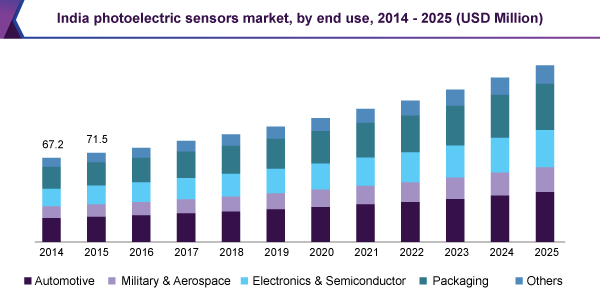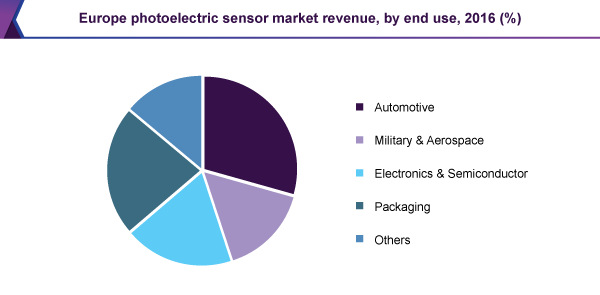- Home
- »
- Sensors & Controls
- »
-
Photoelectric Sensors Market Size And Share Report, 2025GVR Report cover
![Photoelectric Sensors Market Report]()
Photoelectric Sensors Market Analysis Report By Technology (Diffused, Retro-Reflective, Thru-Beam), By End Use (Automotive, Military & Aerospace, Electronics & Semiconductor, Packaging), And Segment Forecasts, 2018 - 2025
- Report ID: GVR-2-68038-312-6
- Number of Report Pages: 87
- Format: PDF, Horizon Databook
- Historical Range: 2014 - 2015
- Forecast Period: 2017 - 2025
- Industry: Semiconductors & Electronics
Industry Insights
The global photoelectric sensors market size was estimated to be USD 1.24 billion in 2016. These sensors are used in manufacturing, packaging, and material handling industries to perform functions such as detection of transparent bottles,monitoring of product presence, detection of wafers in vacuum conveyor system,andmonitoring of conveyor positioning control. They also increase operational efficiency, decrease process time, and enhance productivity. Therefore, increasing adoption in various industrial end-uses is anticipated to boost market demand over the forecast period.

Rising penetration of Industrial Internet of Things (IIoT) has also resulted in proliferated demand. Industrial and process systems rely on sensors for reliable and precise data in all aspects of control and automation. Industrial Internet of Things uses this product to measure positions, pressures, and other significant production parameters.
Constant rise in military expenditure across developed and developing countries is also expected to boost market growth. These sensors are used in the military and aerospace industry for biological agent detection and surveillance to safeguard military as well as civilian population. Furthermore, advent of smart photoelectric sensors is anticipated to augment market growth over the forecast period. These smart sensors offer various advantages such as reduced maintenance cost, enhanced reliability, decreased weight, and reduced downtime.
Technology Insights
The retro-reflective segment accounted for the majority share in 2016 and is expected to grow at the highest rate over the next eight years. This technology enables reduced maintenance and installation costs and is ideal for reliably detecting transparent objects. It can also efficiently detect large as well as small objects.
The thru-beam segment is anticipated to expand at a CAGR exceeding 5.0%. This technology provides benefits such as stable operation and long sensing distances, owing to which, the segment is anticipated to gain traction over the next eight years as well. The diffused segment is anticipated to grow at a moderate rate over the forecast period.
End-use Insights
The automotive segment captured the dominant share in the photoelectric sensors market in 2016. These sensors are used in several automotive applications such as enabling advanced electronic power steering systems, detecting automobiles in parking lots, and detecting shiny objects. Reduced costs associated with photoelectric sensor manufacturing and mandatory emission regulations have also led to increased use in the automotive industry. For instance, the Euro 6 standards for exhaust emissions in Europe requires 56% reduction in nitrogen oxides emission for diesel engines.

The packaging segment is expected to exhibit the highest CAGR over the forecast period. This growth is ascribed to rising automation along with increased penetration of these devices in the packaging industry. Meanwhile, the electronics and semiconductor and military and aerospace segments are anticipated to grow at a moderate rate from 2017 to 2025.
Regional Insights
Asia Pacific captured close to 35.0% of the total market in 2016, which is followed by North America. Asia Pacific is also projected to emerge as the fastest growing market, registering a CAGR of nearly 7.0% from 2017 to 2025. Growing penetration of IIoT across numerous industrial facilities is expected to drive demand in this region. In addition, technological advancements aimed at improving operational efficiency and increasing safety mandates are expected to contribute positively to market demand.
The growth of the European market for photoelectric sensors can be attributed to increasing stringent regulations for industrial automation in several manufacturing facilities in the region. The Middle Eastern market is also expected to witness favorable demand owing to increasing presence of oil and gas companies in the region.
Photoelectric Sensors Market Share Insights
The market for photoelectric sensors is characterized by robust competition owing to major global players as well as small vendors offering a wide range of products. Moreover, the market is fragmented in nature with the presence of key players such as Panasonic Corporation; Keyence Corporation; Rockwell Automation Inc.; Autonics Corporation; and Schneider Electric SE.
Companies adopt various inorganic strategies such as mergers and acquisitions and joint ventures to survive the competition. For instance, SICK AG acquired the industrial business of MICAS. This acquisition helped the former company expand its technology portfolio for port end uses, mines, and heavy industries. On the other hand, MICAS sold its industrial business because the industrial radar segment, which served mainly port and mine operators, could not be developed without a globally operating sales organization.
Recent Developments
-
In March 2023, Panasonic developed an Organic Photoconductive Film (OPF) CMOS Image Sensor Technology. It is a superior color reproduction technology that minimizes color cross-talk and further reduces the sensitivity of each pixel.
-
In August 2022, Rockwell Automation introduced its inexpensive photoelectric sensor for worldwide operations. The 42JA VisiSight M20A series offers a wide range of monitoring modes in an encapsulated, small, cavity-free framework that decreases debris and facilitates simpler sensor cleaning.
Report Scope
Attribute
Details
Base year for estimation
2016
Actual estimates/Historical data
2014 - 2015
Forecast period
2017 - 2025
Market representation
Revenue in USD Million & CAGR from 2017 to 2025
Regional scope
North America, Europe, Asia Pacific, Central & South America, and MEA
Country scope
U.S., Canada, U.K., Germany, Japan, China, India, Brazil, and Mexico
Report coverage
Revenue forecast, company share, competitive landscape, growth factors, and trends
15% free customization scope (equivalent to 5 analyst working days)
If you need specific information that is not currently within the scope of the report, we will provide it to you as a part of the customization.
Segments Covered in the ReportThis report forecasts revenue growth at global, regional, and country levels and provides an analysis of the latest industry trends in each of the sub-segments from 2014 to 2025. For the purpose of this study, Grand View Research has segmented the photoelectric sensors market report on the basis of technology, end use, and region:
-
Technology Outlook (Revenue, USD Million, 2014 - 2025)
-
Diffused
-
Retro-reflective
-
Thru-beam
-
-
End-use Outlook (Revenue, USD Million, 2014 - 2025)
-
Automotive
-
Military & Aerospace
-
Electronics & Semiconductor
-
Packaging
-
Others
-
-
Regional Outlook (Revenue, USD Million, 2014 - 2025)
-
North America
-
U.S.
-
Canada
-
-
Europe
-
U.K.
-
Germany
-
-
Asia Pacific
-
China
-
India
-
Japan
-
-
Central & South America
-
Brazil
-
Mexico
-
-
Middle East & Africa (MEA)
-
Share this report with your colleague or friend.
![gvr icn]()
NEED A CUSTOM REPORT?
We can customize every report - free of charge - including purchasing stand-alone sections or country-level reports, as well as offer affordable discounts for start-ups & universities. Contact us now
![Certified Icon]()
We are GDPR and CCPA compliant! Your transaction & personal information is safe and secure. For more details, please read our privacy policy.
We are committed towards customer satisfaction, and quality service.
"The quality of research they have done for us has been excellent."





